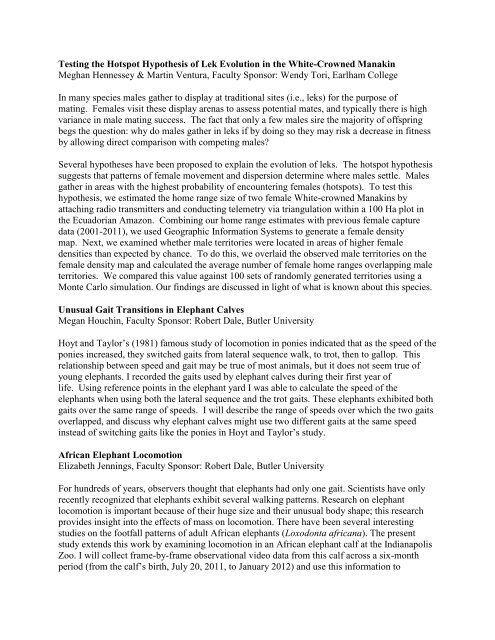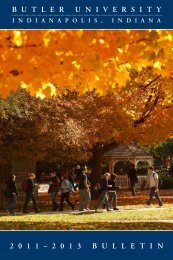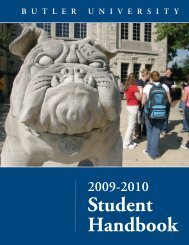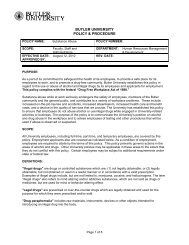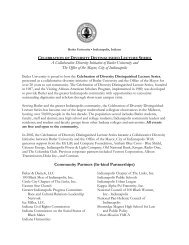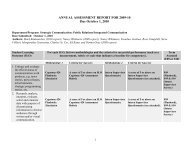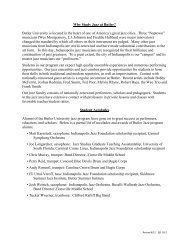Anthropology - Butler University
Anthropology - Butler University
Anthropology - Butler University
Create successful ePaper yourself
Turn your PDF publications into a flip-book with our unique Google optimized e-Paper software.
Testing the Hotspot Hypothesis of Lek Evolution in the White-Crowned Manakin<br />
Meghan Hennessey & Martin Ventura, Faculty Sponsor: Wendy Tori, Earlham College<br />
In many species males gather to display at traditional sites (i.e., leks) for the purpose of<br />
mating. Females visit these display arenas to assess potential mates, and typically there is high<br />
variance in male mating success. The fact that only a few males sire the majority of offspring<br />
begs the question: why do males gather in leks if by doing so they may risk a decrease in fitness<br />
by allowing direct comparison with competing males?<br />
Several hypotheses have been proposed to explain the evolution of leks. The hotspot hypothesis<br />
suggests that patterns of female movement and dispersion determine where males settle. Males<br />
gather in areas with the highest probability of encountering females (hotspots). To test this<br />
hypothesis, we estimated the home range size of two female White-crowned Manakins by<br />
attaching radio transmitters and conducting telemetry via triangulation within a 100 Ha plot in<br />
the Ecuadorian Amazon. Combining our home range estimates with previous female capture<br />
data (2001-2011), we used Geographic Information Systems to generate a female density<br />
map. Next, we examined whether male territories were located in areas of higher female<br />
densities than expected by chance. To do this, we overlaid the observed male territories on the<br />
female density map and calculated the average number of female home ranges overlapping male<br />
territories. We compared this value against 100 sets of randomly generated territories using a<br />
Monte Carlo simulation. Our findings are discussed in light of what is known about this species.<br />
Unusual Gait Transitions in Elephant Calves<br />
Megan Houchin, Faculty Sponsor: Robert Dale, <strong>Butler</strong> <strong>University</strong><br />
Hoyt and Taylor’s (1981) famous study of locomotion in ponies indicated that as the speed of the<br />
ponies increased, they switched gaits from lateral sequence walk, to trot, then to gallop. This<br />
relationship between speed and gait may be true of most animals, but it does not seem true of<br />
young elephants. I recorded the gaits used by elephant calves during their first year of<br />
life. Using reference points in the elephant yard I was able to calculate the speed of the<br />
elephants when using both the lateral sequence and the trot gaits. These elephants exhibited both<br />
gaits over the same range of speeds. I will describe the range of speeds over which the two gaits<br />
overlapped, and discuss why elephant calves might use two different gaits at the same speed<br />
instead of switching gaits like the ponies in Hoyt and Taylor’s study.<br />
African Elephant Locomotion<br />
Elizabeth Jennings, Faculty Sponsor: Robert Dale, <strong>Butler</strong> <strong>University</strong><br />
For hundreds of years, observers thought that elephants had only one gait. Scientists have only<br />
recently recognized that elephants exhibit several walking patterns. Research on elephant<br />
locomotion is important because of their huge size and their unusual body shape; this research<br />
provides insight into the effects of mass on locomotion. There have been several interesting<br />
studies on the footfall patterns of adult African elephants (Loxodonta africana). The present<br />
study extends this work by examining locomotion in an African elephant calf at the Indianapolis<br />
Zoo. I will collect frame-by-frame observational video data from this calf across a six-month<br />
period (from the calf’s birth, July 20, 2011, to January 2012) and use this information to


